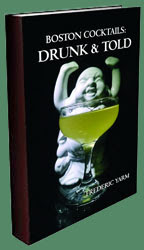
One of the sessions at Tales of the Cocktail this year entitled "Bartending in the 1940's, 1950's and 1960's (the dark ages)" is being moderated by bartending legend Brian Rea. Being the oldest moderator of this year's Tales of the Cocktail at age 83, Brian has a lot to share of his sixty years "behind, and in front of, bars, cocktail lounges, restaurants, nightclubs, and some unmentionable places." Besides this aspect of his life, Brian is well known for having amassed the largest collection of cocktail books, which now reside in a library in Munich, as well as being a co-founder of the Museum of the American Cocktail. To get a better idea of what he would cover at this curiously titled session, I gave Mr. Rea a phone call to discuss what he would be talking about. And given how engrossing his answers and stories were, this session ought to be pretty amazing.
Brian's start at bars was in 1942 when he used to order Boilermakers after a long day of work at the Brooklyn Navy Yard where he was an Apprentice Machinist at age 14 1/2. High school was not for him as he lasted all of 3 days, but his education, albeit less formal, continued on throughout his life. The job at the Navy Yard led him to joining the Merchant Marines during the war. After that, he returned to civilian life working with the Department of Sanitation at an incinerator plant in Manhattan. During this odiferous phase, his life behind the bar got started. How, I asked? The father of the girl he got pregnant and then married was in the liquor store and bar industry, and he got Brian an unpaid spot at a bar where he could be trained in the trade. From there Brian spent a few decades working in various establishments, both classy and classless, where he learned the various aspects of bartending and bar culture. When I inquired how he got taught the trade, he replied that he was trained by the guy who had been there the longest because he could not get a better job elsewhere.

When I queried as to why it was the dark ages, his reply was that they were paid very little, treated like dogs, and did some unscrupulous things. He then got philosophical and started talking about how bars had not really changed much in 4000 years. In Roman times, the taverns had a similar physical set up with cash transactions in exchange for spirits, except with no television and air conditioning in those days. In some aspects, Brian seemed to think that times were better in these dark ages, and other times not so much. For example, he romanticized the liquor of that era as it was stronger with gin starting at 90 proof and whiskey at 86 proof instead of the generally capped-at-80 proof versions of today. On the other hand, he spoke frequently about the adulterating and rectifying of spirits to trick the customers. He was quite proud of his skill of making whiskeys taste older by adding a bit of port to them and his ability to inexpensively refill Southern Comfort bottles with a mix of young whiskey and peach liqueur. Another story he eluded to was best described on his website,
TheBarkeeper:
Many eons ago, I worked in a bar that was referred to as a bust out joint. This was a type of facility where we had various ladies (B girls) hanging around with the purpose of enticing customers to buy them a little drink. Well, the little drink was always a split of champagne, but this was a very special "Sham"pain. In an attempt to keep the costs down, and the girls sober (so they could order more giggle soup), we produced our own special cuvee. At closing time, we would fill the empty champagne bottles with 1/3 third Sauterne, and then fill the balance with soda. The most difficult aspect of the process was using a large pair of pliers to squeeze the cork back in the bottle, as it would flare immediately after opening. Hell we were reusing corks, wire, foil and bottles before anyone even thought of the word 'recycling'. Our cost factor was about 39 cents a bottle, and we sold same at $12.50 to $15.00, which we considered adequate markup. Ah, those were the days of "Better Living Through Chemistry" (thank you DuPont).
Putting these story into perspective, the recent crackdowns on housemade infusions and the similar rectified spirits at bars makes a bit more sense why these laws existed in the first place.
Brian's career also lead him to the position of head barman at high end restaurants like "21" in New York City, and later he left the bar to be the Corporate Beverage Director at Host International which ran a variety of hotel, restaurant, and airport beverage services. During his time as a bartender, his stories range from the difficulties in keeping up with the demand for Ramos Gin Fizzes and developing techniques to satisfy the 400 orders on any given Sunday to reflections of the comings and goings of certain drinks. Back when he started, he needed to know about 80 different drinks to get by including Rob Roys, Sours, Martinis, Manhattans, and Sidecars for the men, and Brandy Alexanders and Bacardi Cocktails for the women. His reflections on the 1960's, when bars were filled with dope smoke and the in vogue drinks took a turn with Harvey Wallbangers, Golden Cadillacs, and Tequila Sunrises, made for some intriguing tales.
Honestly, I was a bit nervous about conducting my first interview, but Brian is a natural story teller and hearing him talk is rather enthralling. I easily understood why he made such a great bartender as I felt like I was on the other side of his bar despite being on the phone on the other side of the country. To wrap things up, I asked if he had a cocktail to recommend that would help crystallize the 1940's, 50's, and 60's, and his sense of humor kicked in again. He recommended the Hemlock Cocktail -- no one has ever complained about it! To avoid a Socratic "I drank what?" moment, I decided to pick one off of his website that he described as being from his era:
Jimmy Roosevelt
• 1 1/2 oz Cognac (Château de Plassons VSOP Cognac)
• 3/4 oz Green Chartreuse
• 2 dash Angostura Bitters
Shake with ice and strain into a champagne flute. Top with sparkling wine (Gloria Ferrer Blanc de Noirs).
 While Charles H. Baker, Jr. has a similar recipe for the Jimmy Roosevelt, this is the version Brian prefers. The drink had a green Chartreuse aroma mixed with dry Champagne notes. The sparkling wine’s sharpness started the sip and was followed by Chartreuse flavors in the middle and Cognac heat on the swallow. There was an almost licorice or anise aftertaste from the herbal notes in this rather dry drink. Overall, the Jimmy Roosevelt would function as a good aperitif or digestif cocktail.
While Charles H. Baker, Jr. has a similar recipe for the Jimmy Roosevelt, this is the version Brian prefers. The drink had a green Chartreuse aroma mixed with dry Champagne notes. The sparkling wine’s sharpness started the sip and was followed by Chartreuse flavors in the middle and Cognac heat on the swallow. There was an almost licorice or anise aftertaste from the herbal notes in this rather dry drink. Overall, the Jimmy Roosevelt would function as a good aperitif or digestif cocktail.
For more about "Bartending in the 1940's, 1950's and 1960's (the dark ages)", go
here.


 1/3 Swedish Punsch (1 oz homemade)
1/3 Swedish Punsch (1 oz homemade)



 This month's
This month's 















 When I queried as to why it was the dark ages, his reply was that they were paid very little, treated like dogs, and did some unscrupulous things. He then got philosophical and started talking about how bars had not really changed much in 4000 years. In Roman times, the taverns had a similar physical set up with cash transactions in exchange for spirits, except with no television and air conditioning in those days. In some aspects, Brian seemed to think that times were better in these dark ages, and other times not so much. For example, he romanticized the liquor of that era as it was stronger with gin starting at 90 proof and whiskey at 86 proof instead of the generally capped-at-80 proof versions of today. On the other hand, he spoke frequently about the adulterating and rectifying of spirits to trick the customers. He was quite proud of his skill of making whiskeys taste older by adding a bit of port to them and his ability to inexpensively refill Southern Comfort bottles with a mix of young whiskey and peach liqueur. Another story he eluded to was best described on his website,
When I queried as to why it was the dark ages, his reply was that they were paid very little, treated like dogs, and did some unscrupulous things. He then got philosophical and started talking about how bars had not really changed much in 4000 years. In Roman times, the taverns had a similar physical set up with cash transactions in exchange for spirits, except with no television and air conditioning in those days. In some aspects, Brian seemed to think that times were better in these dark ages, and other times not so much. For example, he romanticized the liquor of that era as it was stronger with gin starting at 90 proof and whiskey at 86 proof instead of the generally capped-at-80 proof versions of today. On the other hand, he spoke frequently about the adulterating and rectifying of spirits to trick the customers. He was quite proud of his skill of making whiskeys taste older by adding a bit of port to them and his ability to inexpensively refill Southern Comfort bottles with a mix of young whiskey and peach liqueur. Another story he eluded to was best described on his website, 





 1 1/2 oz Cachaça (Cuca Fresca Gold)
1 1/2 oz Cachaça (Cuca Fresca Gold)



 The 2017 collection of 855 drink recipes, bartender tributes, and essays on hospitality from CocktailVirgin's Frederic Yarm. Available at
The 2017 collection of 855 drink recipes, bartender tributes, and essays on hospitality from CocktailVirgin's Frederic Yarm. Available at  The 2012 collection of 505 drink recipes, techniques, and Boston bar recommendations from Frederic Yarm. Available at
The 2012 collection of 505 drink recipes, techniques, and Boston bar recommendations from Frederic Yarm. Available at 



